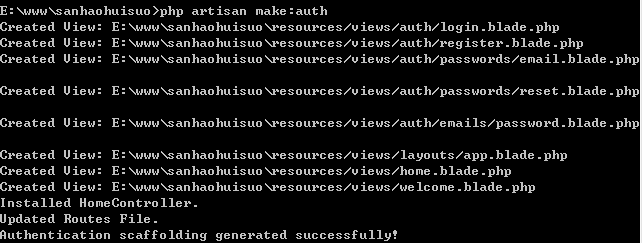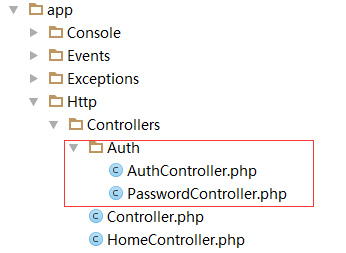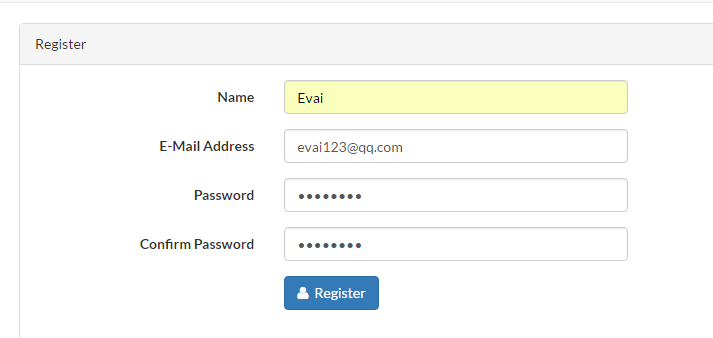Laravel 5.2中多用户认证支持,即同时允许不同数据表用户(如前台用户、后台用户、app用户等)登录认证。下面我们就来简单介绍多用户登录及注册功能实现。
1、生成认证脚手架
首先我们使用Laravel 5.2提供的认证脚手架完成初始化工作,打开终端输入:
php artisan make:auth
该Artisan命令会生成用户认证所需的路由、视图以及HomeController:

接着去查看路由文件routes.php,会发现该文件已经被更新:

其中 Route::auth() 定义了注册登录路由, /home 为认证通过后跳转路由。
这里我重写了一下登录验证的方法:
Route::group(['middleware' => 'web'], function () {
//Route::auth();
//前台用户
Route::any('home/login', 'AuthAuthController@login');
Route::get('home/logout', 'AuthAuthController@logout');
Route::any('home/register', 'AuthAuthController@register');
Route::get('/home', 'HomeController@index');
});
这里的Auth文件夹和类文件在 app/Http/Controllers/Auth 目录下:

接着我们打开AuthContrller.php文件,修改或添加自己的类方法,表的字段名按照数据库创建好的来填写,下面是我修改过的,大家也可以参考:
<?php
namespace AppHttpControllersAuth;
use AppUser;
use IlluminateFoundationAuthAuthenticatesUsers;
use Validator;
use AppHttpRequests;
use Auth;
use Redirect;
use IlluminateHttpRequest;
use AppHttpControllersController;
use IlluminateFoundationAuthThrottlesLogins;
use IlluminateFoundationAuthAuthenticatesAndRegistersUsers;
class AuthController extends Controller
{
/*
|--------------------------------------------------------------------------
| Registration & Login Controller
|--------------------------------------------------------------------------
|
| This controller handles the registration of new users, as well as the
| authentication of existing users. By default, this controller uses
| a simple trait to add these behaviors. Why don't you explore it?
|
*/
use AuthenticatesAndRegistersUsers, ThrottlesLogins;
/**
* Where to redirect users after login / registration.
*
* @var string
*/
protected $redirectTo = '/';
/**
* Create a new authentication controller instance.
*
* @return void
*/
public function __construct()
{
$this->middleware('guest', ['except' => 'logout']);
}
//登录页面
public function login(Request $request)
{
if ($request->isMethod('post')) {
$validator = $this->validateLogin($request->input());
if ($validator->fails()) {
return back()->withErrors($validator)->withInput();
}
if (Auth::guard('web')->attempt($this->validateUser($request->input()))) {
$request->session()->put('email', $request->email);
return Redirect::to('home')->with('success', '登录成功!');
}else {
return back()->with('error', '账号或密码错误')->withInput();
}
}
return view('auth.login');
}
//登录页面验证
protected function validateLogin(array $data)
{
return Validator::make($data, [
'email' => 'required',
'password' => 'required',
], [
'required' => ':attribute 为必填项',
'min' => ':attribute 长度不符合要求'
], [
'email' => '邮箱',
'password' => '密码'
]);
}
//验证用户字段
protected function validateUser(array $data)
{
return [
'email' => $data['email'],
'password' => $data['password']
];
}
//退出登录
public function logout()
{
if(Auth::guard('web')->user()){
Auth::guard('web')->logout();
}
return Redirect::to('home');
}
//注册
public function register(Request $request)
{
if ($request->isMethod('post')) {
$validator = $this->validateRegister($request->input());
if ($validator->fails()) {
return back()->withErrors($validator)->withInput();
}
$user = new User();
$user->name = $request->name;$user->email = $request->email;
$user->password = bcrypt($request->password);
$user->create_time = time();
$user->update_time = time();
if($user->save()){
return redirect('home/login')->with('success', '注册成功!');
}else{
return back()->with('error', '注册失败!')->withInput();
}
}
return view('auth.register');
}
protected function validateRegister(array $data)
{
return Validator::make($data, [
'name' => 'required|alpha_num|max:255',
'email' => 'required|email|max:255|unique:users',
'password' => 'required|min:6|confirmed',
'password_confirmation' => 'required|min:6|'
], [
'required' => ':attribute 为必填项',
'min' => ':attribute 长度不符合要求',
'confirmed' => '两次输入的密码不一致',
'unique' => '该邮箱已经被人占用',
'alpha_num' => ':attribute 必须为字母或数字'
], [
'name' => '昵称',
'email' => '邮箱',
'password' => '密码',
'password_confirmation' => '确认密码'
]);
}
}
然后修改app目录下的 User.php:
<?php
namespace App;
use IlluminateFoundationAuthUser as Authenticatable;
class User extends Authenticatable
{
/**
* The attributes that are mass assignable.
*
* @var array
*/
protected $table = 'users';
//指定主键
protected $primaryKey = 'userid';
//指定允许批量赋值的字段
protected $fillable = [
'name', 'email', 'password',
];
//指定不允许批量赋值的字段
protected $guarded = [];
//自动维护时间戳
public $timestamps = false;
//定制时间戳格式
protected $dateFormat = 'U';
/**
* 避免转换时间戳为时间字符串
*/
public function fromDateTime($value)
{
return $value;
}
//将默认增加时间转化为时间戳
protected function getDateFormat()
{
return time();
}
/**
* The attributes excluded from the model's JSON form.
*
* @var array
*/
protected $hidden = [
'password', 'remember_token', 'app_token','email'
];
}
再去 resource/view/auth 目录下把login.balde.php 和register.blade.php 的form表单 action 分别改为 action="{{ url('home/login') }}" 和 action="{{ url('home/register') }}", 和layouts/app.blade.php 改为:
<!DOCTYPE html>
<html lang="en">
<head>
<meta charset="utf-8">
<meta http-equiv="X-UA-Compatible" content="IE=edge">
<meta name="viewport" content="width=device-width, initial-scale=1">
<title>Laravel</title>
<!-- Fonts -->
<link href="https://cdnjs.cloudflare.com/ajax/libs/font-awesome/4.4.0/css/font-awesome.min.css" rel='stylesheet' type='text/css'>
<link href="https://fonts.googleapis.com/css?family=Lato:100,300,400,700" rel='stylesheet' type='text/css'>
<!-- Styles -->
<link href="https://maxcdn.bootstrapcdn.com/bootstrap/3.3.6/css/bootstrap.min.css" rel="stylesheet">
{{-- <link href="{{ elixir('css/app.css') }}" rel="stylesheet"> --}}
<style>
body {
font-family: 'Lato';
}
.fa-btn {
margin-right: 6px;
}
</style>
</head>
<body id="app-layout">
<nav class="navbar navbar-default">
<div class="container">
<div class="navbar-header">
<!-- Collapsed Hamburger -->
<button type="button" class="navbar-toggle collapsed" data-toggle="collapse" data-target="#app-navbar-collapse">
<span class="sr-only">Toggle Navigation</span>
<span class="icon-bar"></span>
<span class="icon-bar"></span>
<span class="icon-bar"></span>
</button>
<!-- Branding Image -->
<a class="navbar-brand" href="{{ url('/') }}">
Laravel
</a>
</div>
<div class="collapse navbar-collapse" id="app-navbar-collapse">
<!-- Left Side Of Navbar -->
<ul class="nav navbar-nav">
<li><a href="{{ url('/home') }}">Home</a></li>
</ul>
<!-- Right Side Of Navbar -->
<ul class="nav navbar-nav navbar-right">
<!-- Authentication Links -->
@if (Auth::guest())
<li><a href="{{ url('home/login') }}">Login</a></li>
<li><a href="{{ url('home/register') }}">Register</a></li>
@else
<li class="dropdown">
<a href="#" class="dropdown-toggle" data-toggle="dropdown" role="button" aria-expanded="false">
{{ Auth::user()->name }} <span class="caret"></span>
</a>
<ul class="dropdown-menu" role="menu">
<li><a href="{{ url('home/logout') }}"><i class="fa fa-btn fa-sign-out"></i>Logout</a></li>
</ul>
</li>
@endif
</ul>
</div>
</div>
</nav>
@yield('content')
<!-- JavaScripts -->
<script src="https://cdnjs.cloudflare.com/ajax/libs/jquery/2.1.4/jquery.min.js"></script>
<script src="https://maxcdn.bootstrapcdn.com/bootstrap/3.3.6/js/bootstrap.min.js"></script>
{{-- <script src="{{ elixir('js/app.js') }}"></script> --}}
</body>
</html>
还有修改 app/Http/Middleware/Authenticate.php 文件:
<?php
namespace AppHttpMiddleware;
use Closure;
use IlluminateSupportFacadesAuth;
class Authenticate
{
/**
* Handle an incoming request.
*
* @param IlluminateHttpRequest $request
* @param Closure $next
* @param string|null $guard
* @return mixed
*/
public function handle($request, Closure $next, $guard = null)
{
if (Auth::guard($guard)->guest()) {
if ($request->ajax() || $request->wantsJson()) {
return response('Unauthorized.', 401);
} else {
return redirect()->guest('home/login');
}
}
return $next($request);
}
}
2、实现前台用户登录
接下来我们先实现前台用户登录,也就是Laravel自带的User用户登录。通过上面的脚手架,我们已经生成了认证所需的所有代码,剩下要做的就是使用迁移命令创建用户认证相关表:
php artisan migrate
该命令执行后生成 users 表和 password_resets 表,分别为用户主表和密码重置表。
然后我们就可以在浏览器中输入 http://localhost/home 访问页面,发现页面自动跳转到了登录页面,这里的原理就是 app/Http/Middleware/Authenticate.php 文件,现在我们是登录不上去了,所以我们先点击右上角的register注册一个用户:

成功登陆后就可以看到效果了:

这是前台用户登录的效果,然后看后台登录的实现。
3、编辑认证配置文件
要实现多用户认证,首先要配置认证配置文件,在 config 目录下的auth.php,配置如下:
<?php
return [
/*
|--------------------------------------------------------------------------
| Authentication Defaults
|--------------------------------------------------------------------------
|
| This option controls the default authentication "guard" and password
| reset options for your application. You may change these defaults
| as required, but they're a perfect start for most applications.
|
*/
'defaults' => [
'guard' => 'web',
'passwords' => 'users',
],
/*
|--------------------------------------------------------------------------
| Authentication Guards
|--------------------------------------------------------------------------
|
| Next, you may define every authentication guard for your application.
| Of course, a great default configuration has been defined for you
| here which uses session storage and the Eloquent user provider.
|
| All authentication drivers have a user provider. This defines how the
| users are actually retrieved out of your database or other storage
| mechanisms used by this application to persist your user's data.
|
| Supported: "session", "token"
|
*/
'guards' => [
'web' => [
'driver' => 'session',
'provider' => 'users',
],
'api' => [
'driver' => 'token',
'provider' => 'users',
],
'admin' => [
'driver' => 'session',
'provider' => 'admins',
],
],
/*
|--------------------------------------------------------------------------
| User Providers
|--------------------------------------------------------------------------
|
| All authentication drivers have a user provider. This defines how the
| users are actually retrieved out of your database or other storage
| mechanisms used by this application to persist your user's data.
|
| If you have multiple user tables or models you may configure multiple
| sources which represent each model / table. These sources may then
| be assigned to any extra authentication guards you have defined.
|
| Supported: "database", "eloquent"
|
*/
'providers' => [
'users' => [
'driver' => 'eloquent',
'model' => AppUser::class,
],
'admins' => [
'driver' => 'eloquent',
'model' => AppAdmin::class,
],
// 'users' => [
// 'driver' => 'database',
// 'table' => 'users',
// ],
],
/*
|--------------------------------------------------------------------------
| Resetting Passwords
|--------------------------------------------------------------------------
|
| Here you may set the options for resetting passwords including the view
| that is your password reset e-mail. You may also set the name of the
| table that maintains all of the reset tokens for your application.
|
| You may specify multiple password reset configurations if you have more
| than one user table or model in the application and you want to have
| separate password reset settings based on the specific user types.
|
| The expire time is the number of minutes that the reset token should be
| considered valid. This security feature keeps tokens short-lived so
| they have less time to be guessed. You may change this as needed.
|
*/
'passwords' => [
'users' => [
'provider' => 'users',
'email' => 'auth.emails.password',
'table' => 'password_resets',
'expire' => 60,
],
],
];
认证是由 guard 和 provider 两部分构成的(参考用户认证文档),所以我们在这两个配置项中分别新增了 admin 和 admins 选项。
4、创建后台用户模型
接下来我们来实现后台用户登录,首先使用如下Artisan命令生成后台用户模型:
php artisan make:model Admin --migration
带上 --migration 选项会生成对应用户表 admins ,我们定义该数据表字段和 users 一样,生成的文件在database/migration目录下:

Schema::create('admins', function (Blueprint $table) {
$table->increments('adminid');
$table->string('name');
$table->string('account_number', 128);
$table->string('password', 64);
$table->rememberToken();
$table->integer('create_time');
$table->integer('update_time');
});
然后通过运行迁移命令生成该表:
php artisan migrate
然后更新 Admin 模型类如下:
<?php
namespace App;
use IlluminateDatabaseEloquentModel;
use IlluminateFoundationAuthUser as Authenticatable;
class Admin extends Authenticatable
{
//表名
protected $table = 'admins';
//指定主键
protected $primaryKey = 'adminid';
//指定允许批量赋值的字段
protected $fillable = [
'name', 'account_number', 'password',
];
//指定不允许批量赋值的字段
// protected $guarded = [];
//自动维护时间戳
public $timestamps = false;
//定制时间戳格式
protected $dateFormat = 'U';
//将默认增加时间转化为时间戳
protected function getDateFormat()
{
return time();
}
/**
* The attributes excluded from the model's JSON form.
*
* @var array
*/
protected $hidden = [
'password', 'remember_token'
];
}
5、定义后台用户认证路由及控制器
接下来我们来定义后台用户认证路由,修改 routes.php 代码如下:
Route::group(['middleware' => 'web'], function () {
//Route::auth();
//前台用户
Route::any('home/login', 'AuthAuthController@login');
Route::get('home/logout', 'AuthAuthController@logout');
Route::any('home/register', 'AuthAuthController@register');
Route::get('/home', 'HomeController@index');
//后台管理员
Route::any('admin/login', 'AdminAuthController@login');
Route::any('admin/logout', 'AdminAuthController@logout');
Route::any('admin/register', 'AdminAuthController@register');
Route::get('/admin', 'AdminController@index');
});
然后使用Artisan命令创建对应控制器:
php artisan make:controller Admin/AuthController php artisan make:controller AdminController
php artisan make:middleware AuthAdmin
app/Http 目录下会多出Admin认证的文件夹和AdminController.php文件,修改AdminController.php:
<?php
namespace AppHttpControllers;
use IlluminateHttpRequest;
use AppHttpRequests;
class AdminController extends Controller
{
/**
* Create a new controller instance.
*
* @return void
*/
public function __construct()
{
$this->middleware('admin');
}
/**
* Show the application dashboard.
*
* @return IlluminateHttpResponse
*/
public function index()
{
return view('admin.index');
}
}
编辑 Admin/AuthController.php 代码如下:
<?php
namespace AppHttpControllersAdmin;
use AppAdmin;
use IlluminateFoundationAuthAuthenticatesUsers;
use Validator;
use AppHttpRequests;
use Auth;
use Redirect;
use IlluminateHttpRequest;
use AppHttpControllersController;
use IlluminateFoundationAuthThrottlesLogins;
use IlluminateFoundationAuthAuthenticatesAndRegistersUsers;
class AuthController extends Controller
{
use AuthenticatesAndRegistersUsers, ThrottlesLogins;
// protected $redirectTo = 'admin';
// protected $guard = 'admin';
// protected $loginView = 'admin.login';
// protected $registerView = 'admin.register';
public function __construct()
{
$this->middleware('guest:admin', ['except' => 'logout']);
}
//登录
public function login(Request $request)
{
if ($request->isMethod('post')) {
$validator = $this->validateLogin($request->input());
if ($validator->fails()) {
return back()->withErrors($validator)->withInput();
}
if (Auth::guard('admin')->attempt(['account_number'=>$request->account_number, 'password'=>$request->password])) {
return Redirect::to('admin')->with('success', '登录成功!'); //login success, redirect to admin
} else {
return back()->with('error', '账号或密码错误')->withInput();
}
}
return view('admin.login');
}
//登录页面验证
protected function validateLogin(array $data)
{
return Validator::make($data, [
'account_number' => 'required|alpha_num',
'password' => 'required',
], [
'required' => ':attribute 为必填项',
'min' => ':attribute 长度不符合要求'
], [
'account_number' => '账号',
'password' => '密码'
]);
}
//退出登录
public function logout()
{
if(Auth::guard('admin')->user()){
Auth::guard('admin')->logout();
}
return Redirect::to('admin/login');
}
//注册
public function register(Request $request)
{
if ($request->isMethod('post')) {
$validator = $this->validateRegister($request->input());
if ($validator->fails()) {
return back()->withErrors($validator)->withInput();
}
$user = new Admin();
$user->name = $request->name;
$user->account_number = $request->account_number;
$user->password = bcrypt($request->password);
$user->create_time = time();
$user->update_time = time();
if($user->save()){
return redirect('admin/login')->with('success', '注册成功!');
}else{
return back()->with('error', '注册失败!')->withInput();
}
}
return view('admin.register');
}
protected function validateRegister(array $data)
{
return Validator::make($data, [
'name' => 'required|alpha_num|max:255',
'account_number' => 'required|alpha_num|unique:admins',
'password' => 'required|min:6|confirmed',
'password_confirmation' => 'required|min:6|'
], [
'required' => ':attribute 为必填项',
'min' => ':attribute 长度不符合要求',
'confirmed' => '两次输入的密码不一致',
'unique' => '该账户已存在',
'alpha_num' => ':attribute 必须为字母或数字',
'max' => ':attribute 长度过长'
], [
'name' => '昵称',
'account_number' => '账号',
'password' => '密码',
'password_confirmation' => '确认密码'
]);
}
}
编辑 Middleware/AuthAdmin.php 代码如下:
<?php
namespace AppHttpMiddleware;
use Closure;
use IlluminateSupportFacadesAuth;
class AuthAdmin
{
/**
* Handle an incoming request.
*
* @param IlluminateHttpRequest $request
* @param Closure $next
* @param string|null $guard
* @return mixed
*/
public function handle($request, Closure $next, $guard = null)
{
if (Auth::guard('admin')->guest()) {
if ($request->ajax() || $request->wantsJson()) {
return response('Unauthorized.', 401);
} else {
return redirect()->guest('admin/login');
}
}
return $next($request);
}
}
最后再修改Http/Kernel.php,最下方添加一个 admin 认证用户指向:
protected $routeMiddleware = [
'auth' => AppHttpMiddlewareAuthenticate::class,
'auth.basic' => IlluminateAuthMiddlewareAuthenticateWithBasicAuth::class,
'guest' => AppHttpMiddlewareRedirectIfAuthenticated::class,
'throttle' => IlluminateRoutingMiddlewareThrottleRequests::class,
'admin' => AppHttpMiddlewareAuthAdmin::class,
];
6、视图文件创建及修改
最后我们要创建后台用户认证对应视图文件,这里我们简单拷贝前台用户视图模板并稍作修改即可:
cp -r resources/views/auth resources/views/admin
修改 resources/views/admin 目录下登录及注册表单提交地址:
login.blade.php如下:
@extends('layouts.admin') @section('content') <div class="container"> <div class="row"> <div class="col-md-8 col-md-offset-2"> <div class="panel panel-default"> <div class="panel-heading">Login</div> <div class="panel-body"> <form class="form-horizontal" role="form" method="POST" action="{{ url('admin/login') }}"> {!! csrf_field() !!} <div class="form-group{{ $errors->has('account_number') ? ' has-error' : '' }}"> <label class="col-md-4 control-label">Account Number</label> <div class="col-md-6"> <input type="text" class="form-control" name="account_number" value="{{ old('account_number') }}"> @if ($errors->has('account_number')) <span class="help-block"> <strong>{{ $errors->first('account_number') }}</strong> </span> @endif </div> </div> <div class="form-group{{ $errors->has('password') ? ' has-error' : '' }}"> <label class="col-md-4 control-label">Password</label> <div class="col-md-6"> <input type="password" class="form-control" name="password"> @if ($errors->has('password')) <span class="help-block"> <strong>{{ $errors->first('password') }}</strong> </span> @endif </div> </div> <div class="form-group"> <div class="col-md-6 col-md-offset-4"> <div class="checkbox"> <label> <input type="checkbox" name="remember"> Remember Me </label> </div> </div> </div> <div class="form-group"> <div class="col-md-6 col-md-offset-4"> <button type="submit" class="btn btn-primary"> <i class="fa fa-btn fa-sign-in"></i>Login </button> <a class="btn btn-link" href="{{ url('/password/reset') }}">Forgot Your Password?</a> </div> </div> </form> </div> </div> </div> </div> </div> @endsection
register.blade.php 如下:
@extends('layouts.admin') @section('content') <div class="container"> <div class="row"> <div class="col-md-8 col-md-offset-2"> <div class="panel panel-default"> <div class="panel-heading">Register</div> <div class="panel-body"> <form class="form-horizontal" role="form" method="POST" action="{{ url('admin/register') }}"> {!! csrf_field() !!} <div class="form-group{{ $errors->has('name') ? ' has-error' : '' }}"> <label class="col-md-4 control-label">Name</label> <div class="col-md-6"> <input type="text" class="form-control" name="name" value="{{ old('name') }}"> @if ($errors->has('name')) <span class="help-block"> <strong>{{ $errors->first('name') }}</strong> </span> @endif </div> </div> <div class="form-group{{ $errors->has('account_number') ? ' has-error' : '' }}"> <label class="col-md-4 control-label">Acoount Number</label> <div class="col-md-6"> <input type="text" class="form-control" name="account_number" value="{{ old('account_number') }}"> @if ($errors->has('account_number')) <span class="help-block"> <strong>{{ $errors->first('account_number') }}</strong> </span> @endif </div> </div> <div class="form-group{{ $errors->has('password') ? ' has-error' : '' }}"> <label class="col-md-4 control-label">Password</label> <div class="col-md-6"> <input type="password" class="form-control" name="password"> @if ($errors->has('password')) <span class="help-block"> <strong>{{ $errors->first('password') }}</strong> </span> @endif </div> </div> <div class="form-group{{ $errors->has('password_confirmation') ? ' has-error' : '' }}"> <label class="col-md-4 control-label">Confirm Password</label> <div class="col-md-6"> <input type="password" class="form-control" name="password_confirmation"> @if ($errors->has('password_confirmation')) <span class="help-block"> <strong>{{ $errors->first('password_confirmation') }}</strong> </span> @endif </div> </div> <div class="form-group"> <div class="col-md-6 col-md-offset-4"> <button type="submit" class="btn btn-primary"> <i class="fa fa-btn fa-user"></i>Register </button> </div> </div> </form> </div> </div> </div> </div> </div> @endsection
再把 home.blade.php 复制到admin下,重名为index.php,app.blade.php 复制一个并重命名为admin.ablde.php:
cp /resources/views/home.blade.php /resources/views/index.blade.php
cp /resources/views/layouts/app.blade.php /resources/views/layouts/admin.blade.php
admin.blade.php 修改如下:
<!DOCTYPE html> <html lang="en"> <head> <meta charset="utf-8"> <meta http-equiv="X-UA-Compatible" content="IE=edge"> <meta name="viewport" content="width=device-width, initial-scale=1"> <title>Laravel</title> <!-- Fonts --> <link href="https://cdnjs.cloudflare.com/ajax/libs/font-awesome/4.4.0/css/font-awesome.min.css" rel='stylesheet' type='text/css'> <link href="https://fonts.googleapis.com/css?family=Lato:100,300,400,700" rel='stylesheet' type='text/css'> <!-- Styles --> <link href="https://maxcdn.bootstrapcdn.com/bootstrap/3.3.6/css/bootstrap.min.css" rel="stylesheet"> {{-- <link href="{{ elixir('css/app.css') }}" rel="stylesheet"> --}} <style> body { font-family: 'Lato'; } .fa-btn { margin-right: 6px; } </style> </head> <body id="app-layout"> <nav class="navbar navbar-default"> <div class="container"> <div class="navbar-header"> <!-- Collapsed Hamburger --> <button type="button" class="navbar-toggle collapsed" data-toggle="collapse" data-target="#app-navbar-collapse"> <span class="sr-only">Toggle Navigation</span> <span class="icon-bar"></span> <span class="icon-bar"></span> <span class="icon-bar"></span> </button> <!-- Branding Image --> <a class="navbar-brand" href="{{ url('/') }}"> Laravel </a> </div> <div class="collapse navbar-collapse" id="app-navbar-collapse"> <!-- Left Side Of Navbar --> <ul class="nav navbar-nav"> <li><a href="{{ url('/admin') }}">Home</a></li> </ul> <!-- Right Side Of Navbar --> <ul class="nav navbar-nav navbar-right"> <!-- Authentication Links --> @if (!Auth::guest('admin')->user()) <li><a href="{{ url('admin/login') }}">Login</a></li> <li><a href="{{ url('admin/register') }}">Register</a></li> @else <li class="dropdown"> <a href="#" class="dropdown-toggle" data-toggle="dropdown" role="button" aria-expanded="false"> {{ Auth::guard('admin')->user()->name }} <span class="caret"></span> </a> <ul class="dropdown-menu" role="menu"> <li><a href="{{ url('admin/logout') }}"><i class="fa fa-btn fa-sign-out"></i>Logout</a></li> </ul> </li> @endif </ul> </div> </div> </nav> @yield('content') <!-- JavaScripts --> <script src="https://cdnjs.cloudflare.com/ajax/libs/jquery/2.1.4/jquery.min.js"></script> <script src="https://maxcdn.bootstrapcdn.com/bootstrap/3.3.6/js/bootstrap.min.js"></script> {{-- <script src="{{ elixir('js/app.js') }}"></script> --}} </body> </html>
7、实现后台用户认证
在浏览器中访问 http://localhost/admin/register ,同样显示注册页面:

注册并登陆后显示:

好了,至此我们已经完成前后台用户同时登录认证功能。